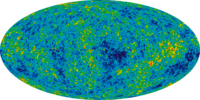
Photo from wikipedia
We investigate the connection between the HI~content, SFR and environment of galaxies using a hydrodynamic simulation that incorporates scaling relations for galactic wind and a heuristic halo mass-based quenching prescription.… Click to show full abstract
We investigate the connection between the HI~content, SFR and environment of galaxies using a hydrodynamic simulation that incorporates scaling relations for galactic wind and a heuristic halo mass-based quenching prescription. We run two zoom-in simulations of galaxy groups with $M_{halo}>10^{13}M_\odot$ at z=0, selected to have quiet merger histories. We track galaxies as they become satellites, and compute the delay time $\tau_{d}$ during which the satellites are similar to central galaxies at a given stellar mass, and a fading time $\tau_{f}$ during which satellites go from gas-rich and star-forming to gas-poor and quiescent. We find $0.7< \tau_{d}< 3$ Gyr at $z=0$, and depends inversely on the satellite halo mass at infall. At z ~ 1 we find ~$0.3< \tau_{d} < 2$ Gyr, broadly consistent with a positive correlation with the Hubble time. For a given halo mass, lower stellar mass galaxies at infall time have higher $\tau_{d}$. We generally find $\tau_{f}\ll \tau_{d}$, ranging between ~ 150 Myr at z~0 and ~ 80 Myr at z ~ 1 based on linear interpolation, with some uncertainty because they are smaller than our simulation output frequency ($200-300$ Myr). $\tau_{f}$ has no obvious dependency on infall halo mass. Both timescales show little difference between HI depletion and SF quenching, indicating that using up the gas reservoir by star formation without refilling is the main mechanism to transform satellite galaxies at these halo masses. At a given physical distance from the center of the main halo of interest, higher redshift galaxies have on average higher cold gas content, but the ratio of gas (HI or H$_2$) to star formation rate is similar, indicating that star formation is consistently fed through reservoirs of HI then H$_2$. For a given amount of HI, galaxies have shorter consumption times in more massive halo structures.
Journal Title: Monthly Notices of the Royal Astronomical Society
Year Published: 2019
Link to full text (if available)
Share on Social Media: Sign Up to like & get
recommendations!